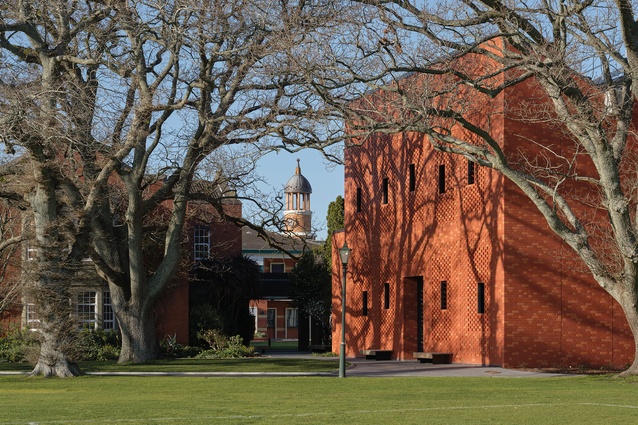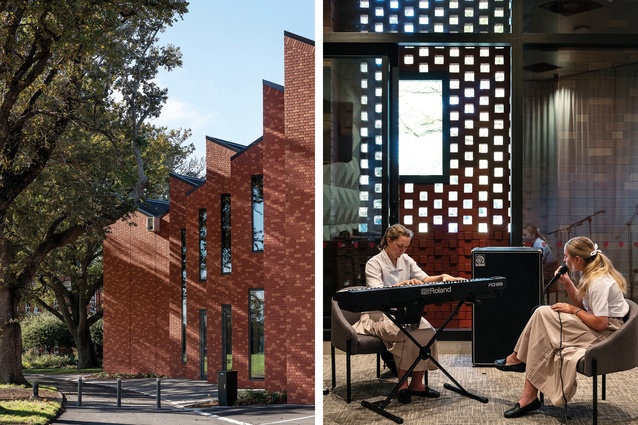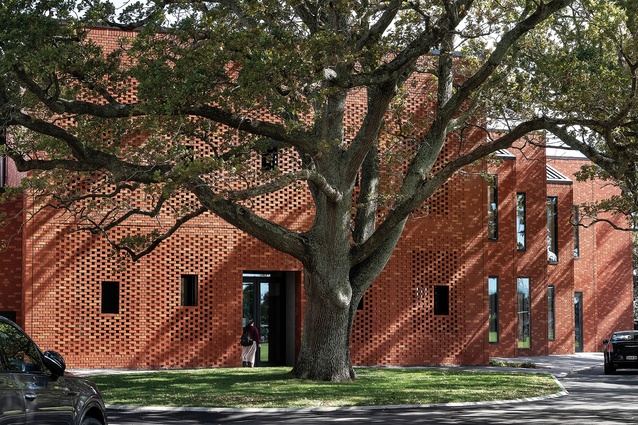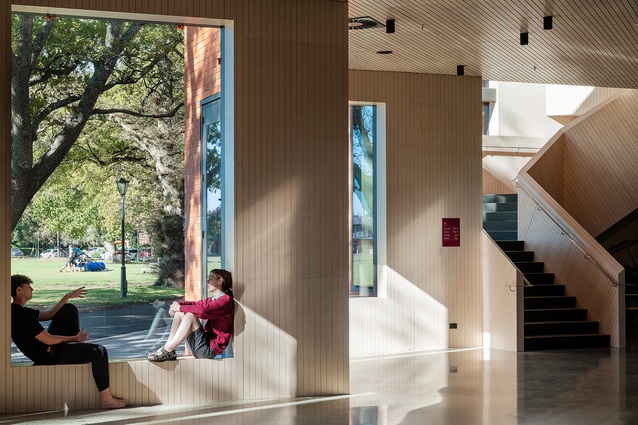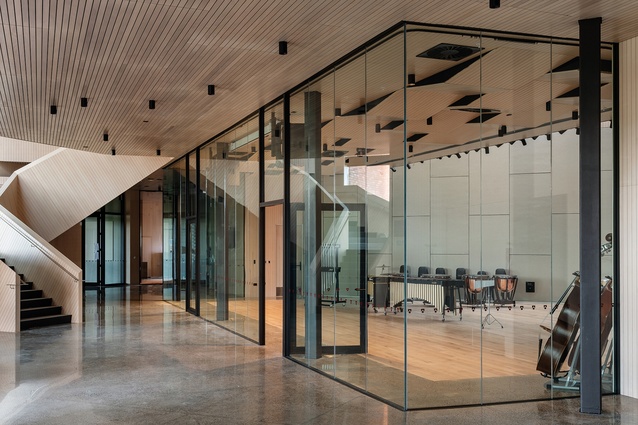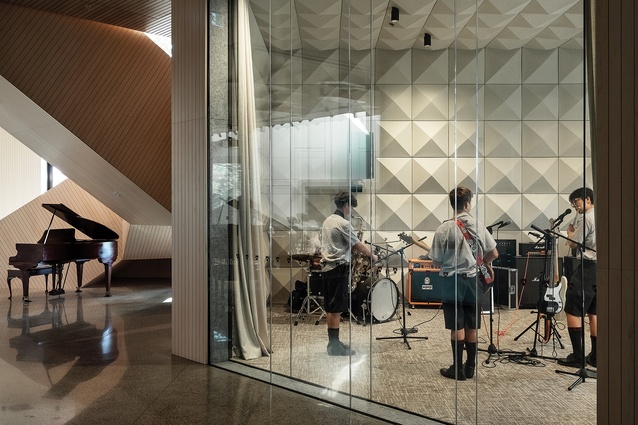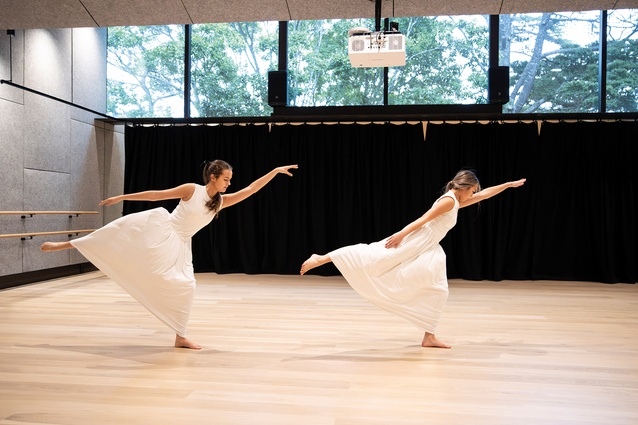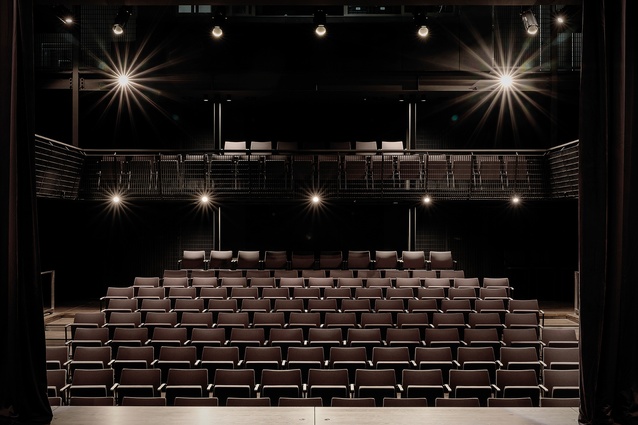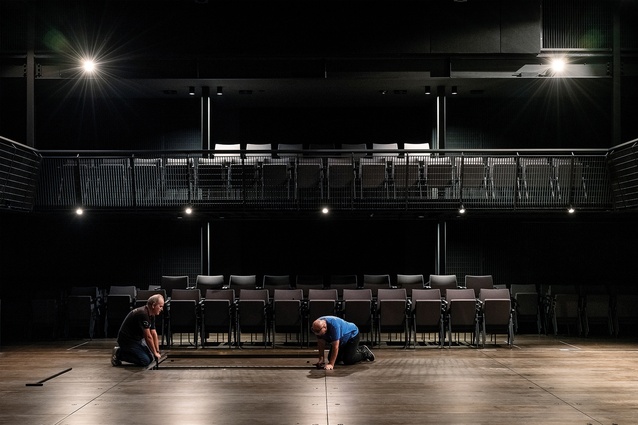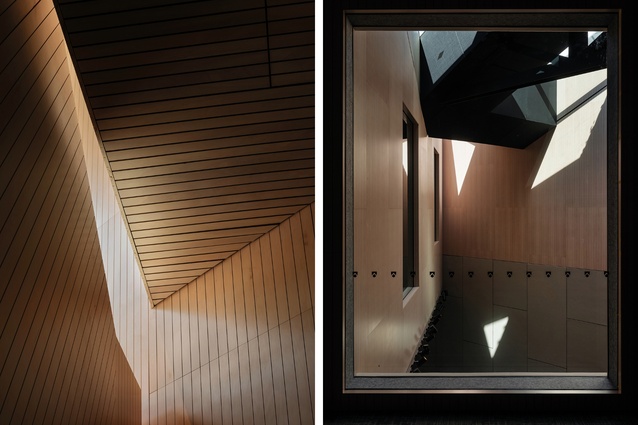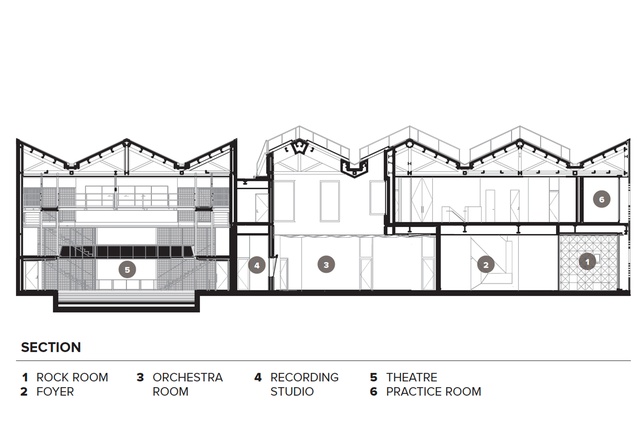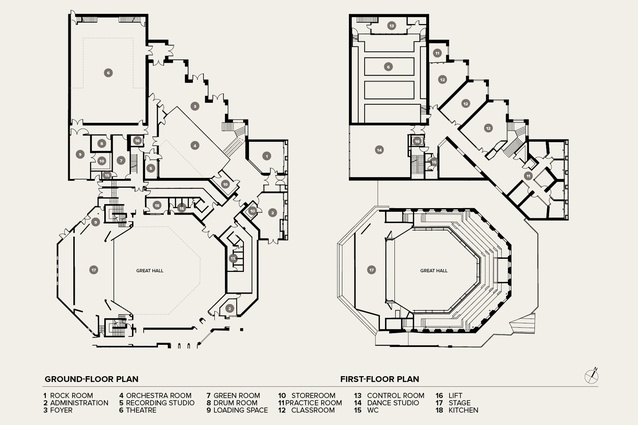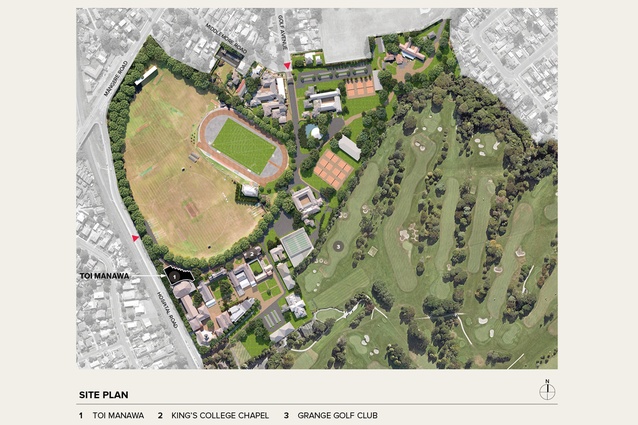A polyphonic assemblage
Dorita Hannah tours Toi Manawa Kīngi Kāreti, King’s College’s new performing arts centre, and enjoys the dynamic tension in Patterson Associates’ design.
In 1925, The King’s College Old Boys’s Memorial Chapel was completed in South Auckland’s Ōtāhuhu on 42 acres of whenua overlooked by Māngere Mountain. The school had relocated there three years previously from Remuera, where it was established in 1896. The architect of this late-Gothic-style brick building, with stained-glass windows set in stone tracery, was Richard Atkinson Abbott (1883–1954), himself a College ‘old boy’. The chapel was a significant building in Abbott’s master plan of redbrick structures, each having its distinctive character and proportioning while adhering to ‘Collegiate Gothic’, a subgenre of Gothic Revival architecture that was popular in Britain and the United States for its associations with Oxford and Cambridge Universities.
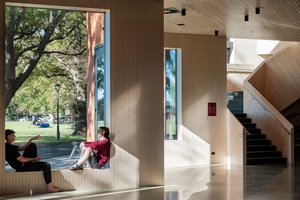
A century later, Andrew Patterson, another King’s ‘old boy’, with his team at Patterson Associates, has completed a commission for the school’s Performing Arts Centre/Toi Manawa (translated as ‘The Heart of the Arts’), an additional signature building in red brick. Unlike Abbott’s revivalist nostalgic style, reiterated in subsequent amenities behind his original buildings, such as the 1990s’ Centennial Complex intimating 1980s’ PoMo-style, Toi Manawa is decidedly contemporary while merging gracefully into the overall environment.
The Performing Arts Centre comprises the first stage in the College’s 2018 Property Master Plan, which aims to improve the campus experience for visitors, enhance a student-centric environment and attract future pupils: principally, increasing their participation in the arts. The centre adjoins The Great Hall (1971) and is sited apart on the same axis as the chapel; its design brief called for an orchestra room, a dance studio, a rock room, a recording studio, practice rooms and a 250-seat theatre with associated teaching spaces and backstage facilities. The campus’ red brick ‘look’ was to be retained, alongside the low pupil-to-teacher ratio that the school proudly upholds, with a flexible auditorium modelled on Rangatira Q Theatre in Tāmaki Makaurau’s CBD.
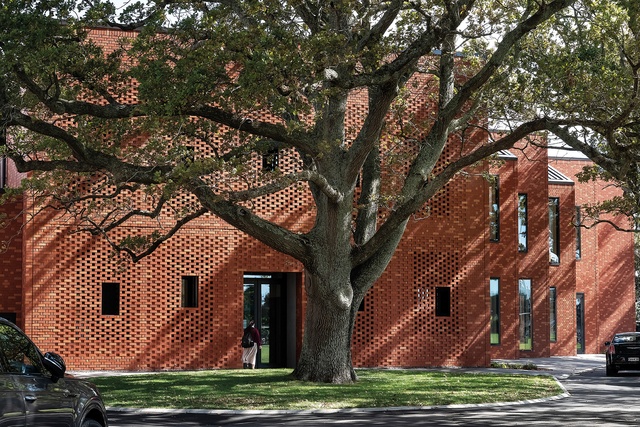
The thought of performing arts schools conjures up imagery of enthusiastic extroverts and a lively assemblage of movement, sound and action, with bodies, voices and instruments warming up and practising their crafts: the most gregarious example being the well-known scene from the 1980 movie Fame where teenagers pour out onto NYC’s 42nd Street to stop traffic and dance on the rooves of cars. This carnivalesque event seems far from the collegiate restraint of King’s green fields campus, with its history of ‘old boys’ and college motto, Virtus Pollet (‘Let Manliness Prevail’). Yet the new facility signals changes, with a quarter of the student population now female and an increasing commitment to the value of arts education in an institution founded on the well-established triad of ‘Faith, Academia and Sports’.
For Patterson, at the heart of this ‘Trinity of Values’ — developing spirit, mind and body — lies “the philosophy of play” as “a non-hierarchical and spontaneous activity that encourages connection to generate creative learning and social benefits”. This was enabled by the sizable endowment from a single donor who stipulated spending it on the performing arts. Whereas ‘play’ is imaginative, collective, liberating and fun-filled, it necessarily involves contestation, competition and conflict — inherent to dramatic structure — within a peaceful context. Such dynamic tension is intrinsic to the architecture as a vibrant accumulation of spaces, belying the rationale of its orthogonally arranged exterior and multi-gabled roof.
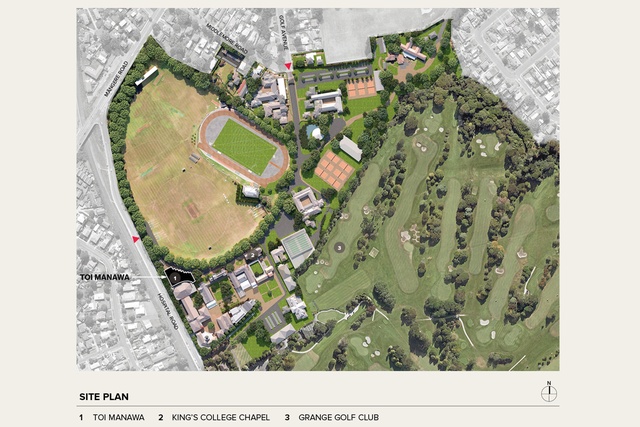
The building is sited at the eastern end of the campus — boggy land requiring 20m-deep screw piles and acoustic insulation to dampen adjacent railway vibrations and road noise — and its patternation of red and orange brickwork continues the school’s heritage tradition, but through pre-cast tilt slabs with brick slips applied. These provide a pleasing tonal effect while saving construction costs and time. It nudges past the unremarkable elevation of the octagonal Great Hall (1971), which was designed to follow the curving line of 100-year-old oak trees between Abbott’s buildings and the northern sports grounds. This siting cleverly recesses the 1200-seat hall while connecting at crucial linkage points to enable shared facilities. Toi Manawa’s sawtooth plan generates a 45-degree orientation within the quadrilinear campus layout, taking advantage of views through the oaks towards the playing fields. As a house-of-play, it addresses the trinity of the sacred chapel to the east, academic college to the south and embodied sports ground to the north. Its placement and planning encourage a ‘polyphony’ of performance forms — as an energetic interweave of ‘many sounds’ that is primarily visuospatial.
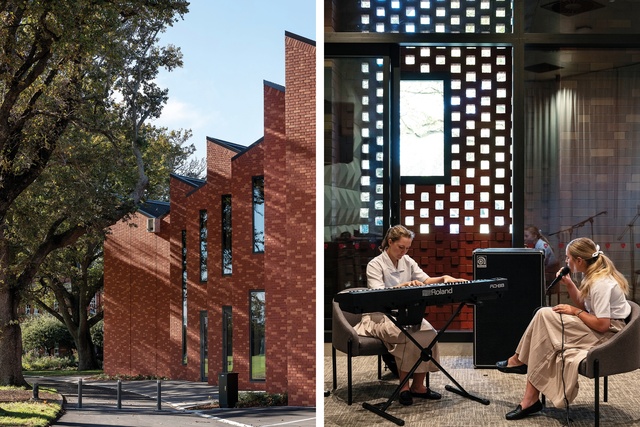
Rather than separate dance, drama and music, the building’s three-dimensional arrangement forms a contrapuntal assemblage while recognising the necessity for acoustic isolation to nurture and refine skills particular to each form. The centralised orchestra room with glazed wall directly faces the zigzagging entry lobby, affording an outlook to the grounds beyond; its triangular double-height void forms a spatial knot with vertical views between floors. A rock room also fronts the lobby, above which classrooms and practice suites are accessed by a sculptural staircase clad in the blonde plywood sarking that wraps walls and ceilings. Various collaged materials, faceted surfaces and room geometries suggest spaces carved by sound and movement, especially the dance studio with felt panels, angled timber ceilings and clerestory windows.
The architects approached this building as a ‘dynamic speaker box’, defined by the perforated brick screen wall on the east-facing elevation with playfully undulating openings. Behind these, the music rooms are enclosed by sliding interior and exterior acoustic glass doors, which can be passively operated by teachers and students. Within the building, these glazed partitions effectively provide acoustic isolation. Although muffled practice can be heard from the corridors, any instrumental sound is thoroughly dampened between the practice chambers. However, the exterior doors can slide back to emit sound through the punctured wall, allowing the building to sound out whatever is being rehearsed within.
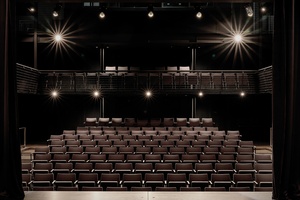
The flexible nature of the auditorium, with galleries on three sides and adaptable flooring modules, offers an extensive range of formats — including flat-floor catwalk and end-stage seating — providing an ideal environment for students to explore. Referring directly to Q Theatre’s 350–450-seat ‘flexiform’ auditorium — a venue I’m familiar with, having formulated its initial brief and ‘courtyard’ configuration — this intimate 250-seat space provides an effective kit-of-parts to achieve multiple performer-audience relationships. Easy access to overhead gantries enables safe technical instruction and experimentation, although sight lines from the control room are somewhat limited. Also, more consideration could have been given to shared backstage changing facilities. The ‘green room’ (conventionally an actors’ lounge) offers necessary countertops and mirrors for dressing and make-up, and upper-level glazed classrooms provide further essential space. However, the back-of-house would benefit from extra toilets, showers and discrete changing rooms to accommodate more efficiently a range of events in both the auditorium and The Great Hall, especially for larger groups of performers and diverse genders.
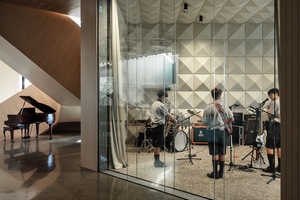
Tāmaki Makaurau generally lacks well-equipped and inspiring performance spaces, with professionals and community groups increasingly turning to school venues, such as Auckland Grammar’s Centennial Theatre and Epsom Girls’ Grammar School’s Raye Freedman Arts Centre, for hire. While Toi Manawa’s auditorium could productively offer an even more inspiring state-of-the-art facility, it is principally focused as a teaching space and would require not only those necessary backstage spaces but also front-of-house amenities for ticketing and catering. However, the welcoming lobby can easily accommodate food and beverage through mobile units. Currently housing a baby grand piano, organ and harmonium, it would more effectively fulfil its potential as a vibrant hangout space through judiciously selected and well-placed furniture while taking advantage of the deep window reveals for supplementary seating. Even though this also applies to the exterior patios formed by the zigzag walls, such furnishing requires a small additional investment by the college to animate the facility further.
As I left my tour of the building, its foyer filled with students who gathered around someone playing the baby grand piano while others utilised the adjoining administration office as a drop-in centre and even more practised behind the glazed walls of the rock and orchestra rooms. The venue’s excellent acoustics and architectural design allowed these overlapping events to coexist as a polyphonic assemblage efficacious for a performing arts centre named ‘manawa’ — which not only means ‘heart’ but also ‘breath’ and ‘pulse’ — successfully rendering it indeed a lively venue.



